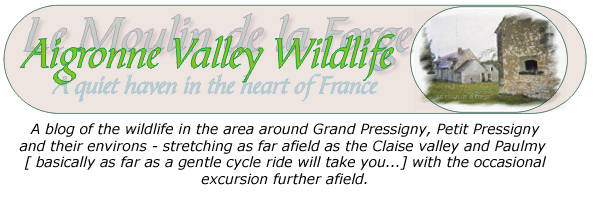 |
| Starling [Sturnus vulgaris] Étourneau sansonnet |
now we understand why they are a nuisible in France...
it was one of those "Wow!!" moments.
I was looking out of the kitchen window when they started coming past...
and, as they kept coming, I became a little hypnotised by the movement of the birds.
They were flying straight down the Aigronne Valley...
East to West!
 |
| What it looked like... but this was from later and not so close! |
When I'd pulled myself together...
after a couple of minutes, I might add...
I called upstairs to Pauline...
mainly because she hadn't "informed" me of the flypast...
so I knew she hadn't, at that point, spotted them.
They continued flying past for about another minute...
and as the tail-end left my view point I dashed to the "front" door...
grabbing a camera off the table en-route...
 |
| They were this close to the house... but travelling East to West!! |
and not just in front of the kitchen window...
they were still passing on the other side of the longére!!
But only for a few seconds...
So...
I didn't get any pictures at that point...
but...
looking over toward Grandmont and La Jarrie a couple of hours later...
Pauline spotted another well known starling "sight"...
a "murmuration"....
this can take place at a roost in the evening...
or if there is a raptor about...
quite often below the flock...
waiting to pick one off as they settle into a tree...
or onto the ground.
As we saw our "murmuration" around mid-morning...
'twas probably the latter.
 |
| The starlings stretch from the top of the picture to the bottom... view large by clicking on these pictures for the full effect. |
really tiny... when compared with the two U-Tube videos below.
 |
| Here they are spiralling up and down... |
this is the first time I have seen it "live"...
"as seen on TV" wildlife action being my only viewings up to yesterday!!
 |
| They are off the top of this picture and linked by some birds to the two "blobs" at the bottom... |
 |
| ...these two blobs!! |
The flock Pauline spotted, broke up and about half flew towards us and directly overhead...
and as the camera was in hand, I could at least show you what the sky looked like in the morning...
albeit from the wrong direction...
they are the two flight shots at the start!.
So... here's a couple of U-Bend videos of these wonderful displays...
starting with one filmed at the RSPB's Otmoor Reserve, just outside Oxford...
which has a very good commentary...
I recommend watching this one full screen...
This second one is at Gretna Green...
and there is a single falcon around, near the roost...
another favourite place for a raptor to lie in wait!!
And "Tweet of the Day" on Radio Four this morning was.....
 |
| The Starling |
presented by David Attenborough!!





















































